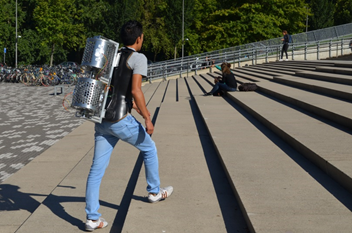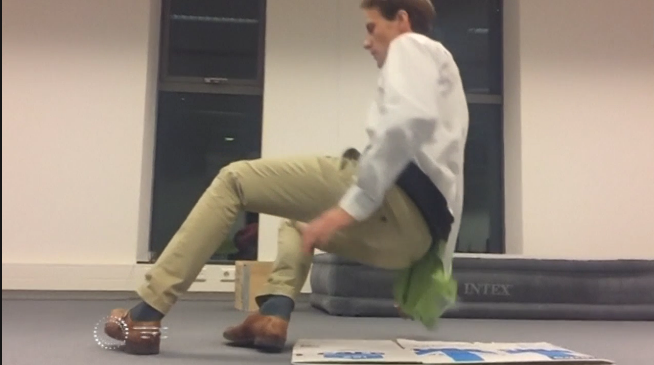Project Overview
Body
Principal Investigator: Heike Vallery, TU Delft, NL
Co - Investigators: Daniel Lemus (TU Delft, NL), Jurriaan de Groot (Leiden University Medical Center, NL), Carel Meskers (University Amsterdam Medical Center, NL)
Synopsis/Goals of the Project
The goal of this development project is to enable balance therapy as part of a patient’s daily life, blurring the border between “assistive” and “therapeutic” technology: We will develop a portable device that is easy to wear and does not interfere with a patient’s gait, unless when necessary to prevent a fall.
Project Aim #1: Develop a wearable assistive device for fall prevention that can be worn as a backpack on the upper body. The device is based on “control moment gyroscopes” (CMGs), which allow the controlled application of moments on the body and do not generate undesired parasitic moments in response to human movement.
Project Aim #2: Investigate intervention paradigms for fall prevention, in order to develop controllers that secure the patient in an optimal way, preventing falls but avoiding excessive help. The strategies will be evaluated in experiments with healthy volunteers and patients wearing the prototype.
Major Accomplishments
Body
Gyroscopic Balance Assistance Device

Falls are an urgent problem for an ageing society, being one of the major reasons for hospitalization and death. To provide wearable balance assistance in daily life for users with increased risk of falls, we have realized two prototypes of a gyroscopic-actuated backpack. With the first prototype, we demonstrated that it can balance an inverted pendulum [1,2], which served as a simplified model of an upright human, and preliminary tests showed that the device can indeed influence human balance substantially [3].
The second prototype (see figure) contains a new mechanical principle that does not suffer from the undesired parasitic effects that are normally caused by the fast spinning masses in conventional control moment gyroscopes. With this patented new technology [4], in combination with robust control algorithms [5], users will be able to perform rotations such as bending over or turning without feeling any interaction except for the pure weight of the backpack. However, when it is needed, the actuators are capable of generating large torques, as needed to prevent or slow down a fall.
Currently, tests are being started using the new actuators in the balance-assisting backpack.
To follow up on this successful technical development within MARS3, the Dutch national research funding agency NWO has provided the prestigious “Vidi” grant with 800 kEUR budget, such that new versions can be produced, reduced in weight and size, allowing use in daily life.
For more detailed information (scientific publications, etc.):
[1] Video of the gyroscopes balancing an inverted pendulum.
[2] Lemus, D. & Vallery, H., “Towards Gyroscopic Balance Assistance: Proof of Concept”, in Proceedings of the 36th Annual International Conference of the IEEE Engineering in Medicine and Biology Society (EMBC14), 2014.
[3] Video of the influence of the gyroscopic actuators on the balance of a human subject.
[4] Vallery, H. & Lemus, D. (filed 2015). Gyroscope for Balance Assist, Dutch patent application N2014927.
[5] Andrew Berry, Daniel Lemus, Robert Babuska, and Heike Vallery: Directional Singularity-Robust Torque Control for Gyroscopic Actuators. IEEE/ASME Transactions on Mechatronics, 2016, 21(6), 2755 - 2763.
- [6] Project website: dbl.tudelft.nl
Body
Fall detection algorithms for a wearable airbag to prevent hip fractures

For wearable devices that actively prevent falls or mitigate their consequences, a critical prerequisite is knowledge on the user’s current state of balance. To keep such wearable systems practical and to achieve high acceptance, only very limited sensor instrumentation is possible, often restricted to inertial measurement units at waist level. We augmented this limited sensor information by combining it with additional knowledge on human gait, in the form of an observer concept [1]. This enables us to even observe the location of the feet with respect to the center of mass, while only instrumenting with inertial measurement units at waist level. This information provides deeper insight into the wearer’s state of balance and can help predict falls.
We performed tech transfer of these fall detection algorithms by porting them to a simple wearable device (figure): a hip-protecting airbag. The technology is now being commercialized by the Dutch start-up company WOLK. This attracted considerable media attention, for example [2].
For more detailed information (scientific publications, etc.):
[1] C. Paiman, D. Lemus Perez, D. Short Sotero, H. Vallery, Observing the state of balance with a single upper-body sensor, Frontiers In Robotics and AI, 3(11), p.1-17, 2016
[2] Reuters video showing the fall airbag and its development:
